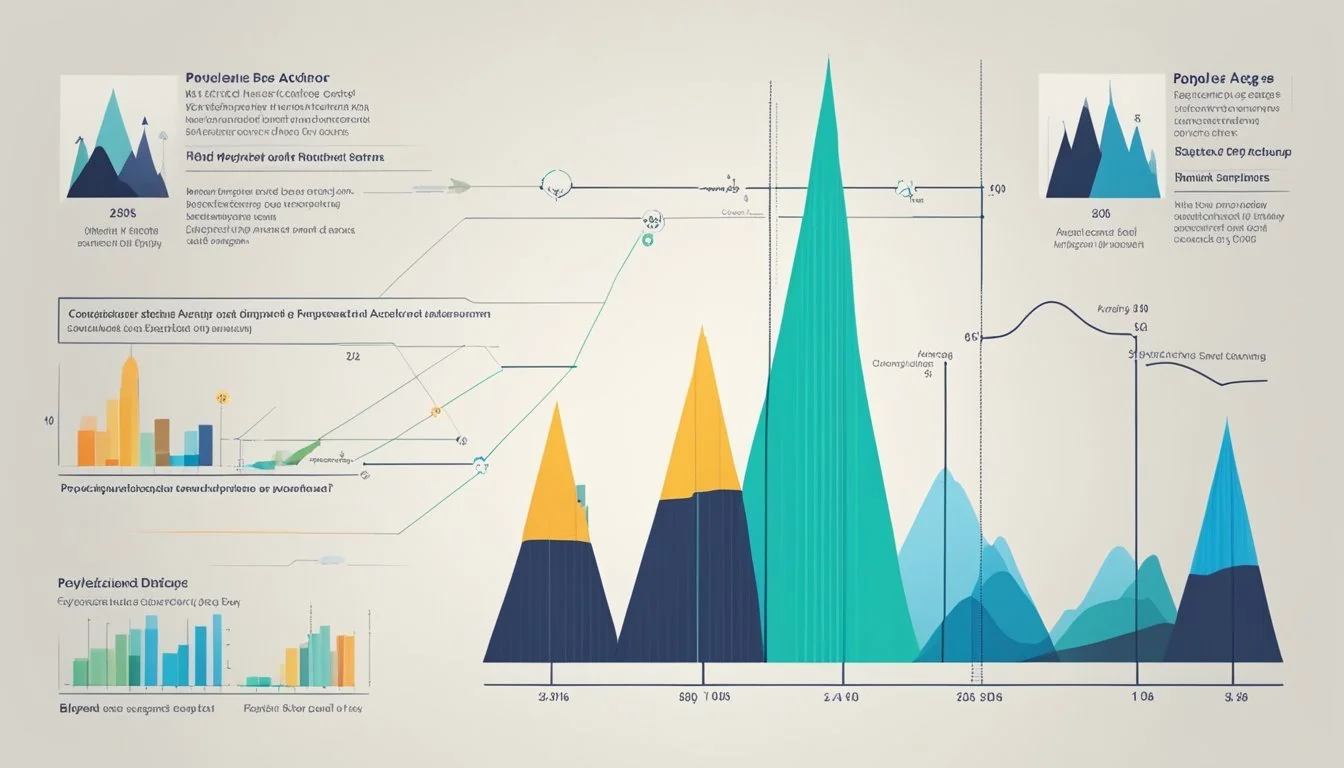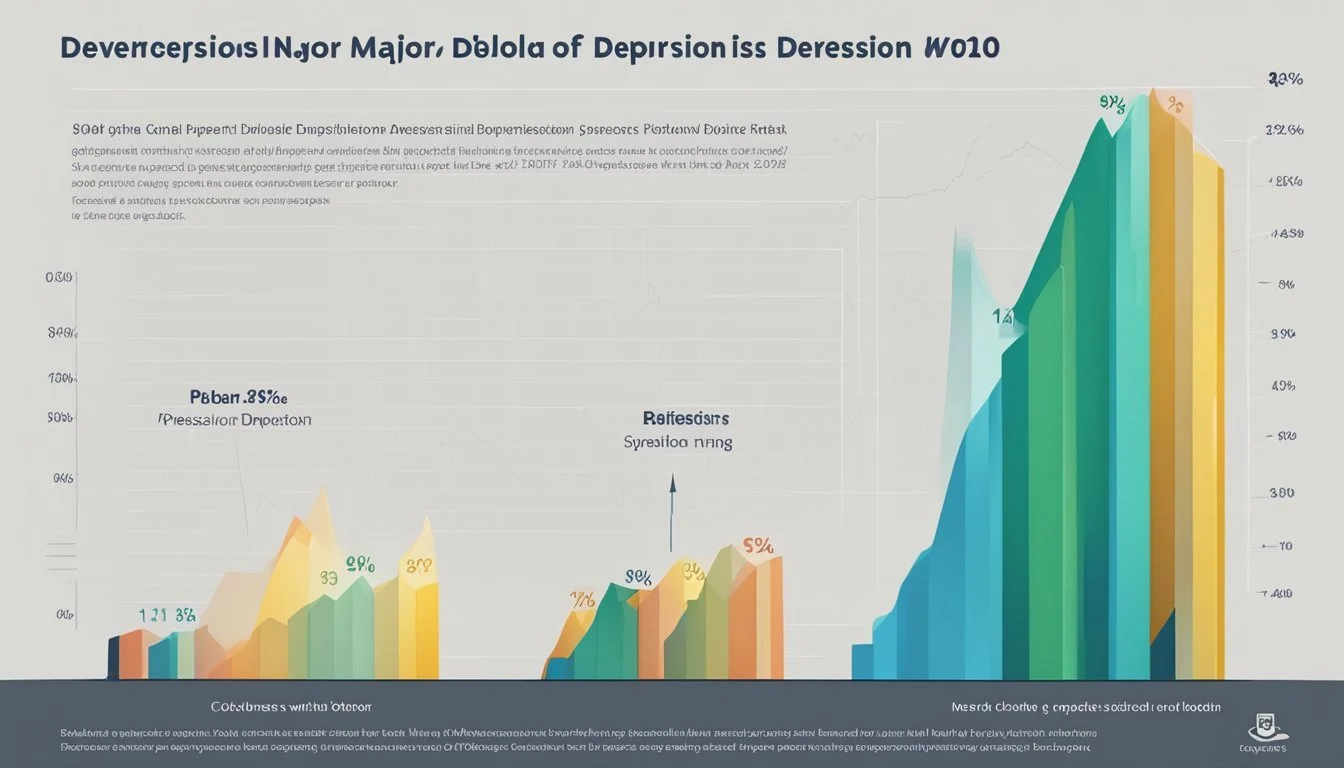12 Bipolar Disorder Statistics That Might Surprise You
Eye-Opening Facts About Mental Health
Bipolar disorder is a complex mental health condition characterized by significant mood swings between manic and depressive episodes. This article explores surprising statistics about bipolar disorder, shedding light on its prevalence, impact, and treatment.
Approximately 2.6% of the U.S. adult population is affected by bipolar disorder each year, translating to about 5.7 million individuals. This mental health condition can have profound effects on a person's daily life, relationships, and overall well-being. Understanding the statistics surrounding bipolar disorder can help raise awareness and promote better support for those affected by this challenging condition.
1) Over 46 million worldwide have bipolar disorder
Bipolar disorder affects a significant portion of the global population. According to recent data, approximately 46 million people around the world live with this condition.
This statistic highlights the widespread nature of bipolar disorder across different countries and cultures. It underscores the importance of global mental health initiatives and research efforts.
The prevalence of bipolar disorder varies by region and demographic factors. Some populations may have higher rates due to genetic, environmental, or socioeconomic influences.
Accurate diagnosis and reporting contribute to these statistics. As awareness and understanding of bipolar disorder improve, the reported numbers may change.
This global figure emphasizes the need for accessible mental health care and support systems worldwide. It also calls attention to the potential economic and social impacts of bipolar disorder on a global scale.
2) Bipolar disorder affects men and women equally
Bipolar disorder shows no gender bias in its prevalence. Research indicates that men and women are equally likely to develop this mental health condition.
While the overall occurrence rate is similar, there are some differences in how bipolar disorder manifests between genders. Men tend to experience their first episode of bipolar disorder earlier than women, typically by 4-5 years.
Women are more prone to rapid cycling, which involves frequent shifts between manic and depressive episodes. They also have a higher likelihood of experiencing seasonal patterns in their symptoms.
Men with bipolar disorder are more likely to present with manic episodes initially. In contrast, women often first exhibit depressive symptoms when seeking treatment.
Comorbid conditions also vary between genders. Women with bipolar disorder have higher rates of anxiety disorders, including phobias and panic disorder. They are also more susceptible to post-traumatic stress disorder.
Despite these differences, it's important to note that bipolar disorder can significantly impact both men and women's lives. Proper diagnosis and treatment are crucial for managing symptoms and improving quality of life, regardless of gender.
3) The average age of onset is 25
Bipolar disorder typically emerges in young adulthood, with the average age of onset being 25 years old. This statistic is supported by multiple sources, including the National Alliance on Mental Illness and various research studies.
While 25 is the average, it's important to note that bipolar disorder can develop at different ages. Some individuals experience symptoms during their teenage years, while others may not show signs until later in life.
The onset of bipolar disorder in the mid-twenties coincides with a critical period of life transitions. Many people are finishing their education, starting careers, and forming long-term relationships during this time.
Early recognition and diagnosis of bipolar disorder are crucial for effective treatment and management. Identifying symptoms around the average age of onset can lead to better outcomes and improved quality of life for those affected by the condition.
4) Cyclothymia is a milder form of bipolar disorder
Cyclothymia, also known as cyclothymic disorder, is a less severe variant of bipolar disorder. It involves frequent mood fluctuations between hypomanic and depressive episodes.
People with cyclothymia experience significant changes in energy levels and mood. These shifts can occur multiple times over the course of days or weeks.
Symptoms of cyclothymia include exaggerated happiness, extreme optimism, and inflated self-esteem during hypomanic periods. During depressive episodes, individuals may feel sad, hopeless, or lose interest in activities.
While cyclothymia is milder than bipolar disorder, it can still impact daily functioning. The condition is characterized by persistent instability in mood and energy levels.
Treatment for cyclothymia typically involves a combination of medication and psychotherapy. This approach helps manage symptoms and improve quality of life for those affected.
Cyclothymia is a lifelong condition, but with proper management, many individuals lead fulfilling lives. Recognizing the signs early can lead to better outcomes and more effective treatment.
5) Bipolar I Disorder includes manic episodes for at least 7 days
Bipolar I disorder is characterized by the occurrence of at least one manic episode. These manic episodes must persist for a minimum of 7 days, or be severe enough to require immediate hospitalization.
During a manic episode, individuals experience an abnormally elevated mood and increased energy levels. This state affects their daily functioning and can lead to impulsive or risky behaviors.
Symptoms of mania may include decreased need for sleep, racing thoughts, and grandiose ideas. People in a manic state often engage in goal-directed activities at a higher rate than usual.
While manic episodes define Bipolar I disorder, most people with this condition also experience depressive episodes. These depressive periods typically last at least two weeks and involve feelings of sadness, hopelessness, and loss of interest in activities.
Proper diagnosis of Bipolar I disorder requires careful evaluation by a mental health professional. Treatment often involves a combination of medication and psychotherapy to manage both manic and depressive symptoms.
6) Bipolar II Disorder involves hypomanic but not full manic episodes
Bipolar II disorder is characterized by alternating episodes of depression and hypomania. Unlike bipolar I disorder, individuals with bipolar II do not experience full-blown manic episodes.
Hypomania is a milder form of mania. It involves elevated mood, increased energy, and changes in behavior, but does not cause severe impairment or require hospitalization.
During hypomanic episodes, people may feel euphoric or irritable. They often experience increased productivity, decreased need for sleep, and heightened self-esteem.
While hypomania can be disruptive, it does not reach the intensity of full mania. Manic episodes, seen in bipolar I disorder, involve more severe symptoms and can lead to significant problems in daily functioning.
Bipolar II disorder is often misdiagnosed as depression because hypomanic episodes may go unrecognized. Proper diagnosis is crucial for effective treatment and management of the condition.
Treatment for bipolar II typically involves a combination of mood stabilizers, psychotherapy, and lifestyle changes. With appropriate care, many individuals with bipolar II can lead stable and fulfilling lives.
7) Genetics play a crucial role in bipolar disorder risk
Bipolar disorder has a strong genetic component. Studies show that individuals with a first-degree relative diagnosed with bipolar disorder have a significantly higher risk of developing the condition themselves.
Research indicates that heritability estimates for bipolar disorder range from 60% to 85%. This means that genetic factors account for a substantial portion of the risk for developing the disorder.
Genome-wide association studies have identified multiple genetic variants associated with bipolar disorder. These variants individually have small effects, but collectively contribute to the overall risk.
Scientists have discovered shared genetic risk factors between bipolar disorder and other psychiatric conditions like schizophrenia and major depression. This suggests some overlap in the genetic underpinnings of these disorders.
While genetics play a crucial role, environmental factors also influence bipolar disorder risk. The interplay between genetic predisposition and environmental triggers likely contributes to the development of the condition.
Ongoing research aims to further elucidate the complex genetic architecture of bipolar disorder. Advances in this field may lead to improved diagnosis, treatment, and prevention strategies in the future.
8) Substance abuse co-occurs in 60% of those with bipolar
Substance abuse is a significant concern for individuals with bipolar disorder. Research indicates that approximately 60% of people with bipolar disorder also struggle with substance use issues.
This high rate of comorbidity presents unique challenges for diagnosis and treatment. Substance use can mask or exacerbate bipolar symptoms, making it difficult to distinguish between the effects of substances and the underlying mood disorder.
Genetic factors may play a role in this connection. Studies suggest there is overlap in genetic predisposition for both bipolar disorder and substance use disorders, particularly alcohol use disorder.
The relationship between bipolar disorder and substance abuse appears to be bidirectional. Bipolar symptoms can lead some individuals to self-medicate with drugs or alcohol. Conversely, substance use may trigger or worsen manic or depressive episodes.
Common substances misused by people with bipolar disorder include alcohol, cannabis, and prescription medications. This comorbidity often results in more severe symptoms, increased risk of suicide, and poorer treatment outcomes.
9) Lithium is a common treatment for bipolar disorder
Lithium has been a cornerstone in the treatment of bipolar disorder for nearly 70 years. It is widely recommended by medical guidelines as a first-line option for maintenance therapy in bipolar patients.
This medication is particularly effective in managing manic episodes and preventing mood swings. Lithium also shows promise in reducing the risk of suicide among individuals with bipolar disorder.
Despite its efficacy, lithium use comes with potential side effects. Common issues include hand tremors, increased thirst, and frequent urination. Doctors may adjust dosages or prescribe additional medications to manage these effects.
Lithium treatment often requires careful monitoring of blood levels to ensure safety and effectiveness. Regular check-ups and blood tests are typically part of the treatment protocol.
While other mood stabilizers are available, lithium remains one of the most studied and reliable options for bipolar disorder management. Its long-standing use and proven track record make it a valuable tool in the psychiatric treatment arsenal.
10) Bipolar disorder increases risk of suicide
Bipolar disorder significantly elevates the risk of suicide among affected individuals. Studies show that people with bipolar disorder have a 10 to 30 times higher likelihood of dying by suicide compared to the general population.
The lifetime suicide attempt rate for those with bipolar disorder ranges from 20% to 60%. This means that up to 6 out of 10 individuals with the condition may attempt suicide at least once in their lives.
The completed suicide rate for bipolar disorder is estimated between 4% and 19%. This stark statistic underscores the critical need for effective treatment and support systems for those diagnosed with the condition.
Suicide risk in bipolar disorder stems from both environmental and genetic factors. The complex interplay of these elements contributes to the heightened vulnerability observed in this population.
Recognizing the increased suicide risk associated with bipolar disorder is crucial for healthcare providers, family members, and patients themselves. Early intervention, ongoing treatment, and robust support networks play vital roles in mitigating this risk.
11) 10-20% of teens with major depression develop bipolar
Teenagers experiencing major depression face a significant risk of developing bipolar disorder. Studies indicate that 10-20% of adolescents diagnosed with major depressive disorder eventually progress to bipolar disorder.
This transition typically occurs within a few years of the initial depression diagnosis. Recognizing early signs of bipolar disorder in depressed teens is crucial for appropriate treatment and management.
Symptoms that may suggest a shift towards bipolar disorder include periods of increased energy, decreased need for sleep, and engaging in risky behaviors. Mood swings that are more severe than typical teenage emotional changes can also be indicative.
Healthcare providers closely monitor depressed teens for these potential indicators. Early intervention and accurate diagnosis can lead to better outcomes for young people at risk of developing bipolar disorder.
Parents and caregivers should be aware of this potential progression. Staying vigilant and maintaining open communication with healthcare professionals is essential for supporting teens with depression.
12) Women more likely to experience rapid-cycling bipolar
Rapid cycling is a pattern in bipolar disorder characterized by frequent mood episodes. Studies indicate that women are more susceptible to this challenging variant of the condition.
Approximately 10-20% of individuals with bipolar disorder experience rapid cycling. Among this group, women represent a higher proportion compared to men.
The reasons for this gender disparity are not fully understood. Hormonal fluctuations and thyroid issues, which are more common in women, may play a role in the development of rapid cycling.
Rapid cycling can be particularly disruptive, as it involves four or more distinct mood episodes within a year. These frequent shifts between mania, hypomania, and depression can complicate treatment and daily functioning.
Women with bipolar II disorder appear to have an increased likelihood of experiencing rapid cycling compared to those with bipolar I. This subtype is characterized by alternating episodes of hypomania and depression.
Recognizing the higher prevalence of rapid cycling in women is crucial for tailoring effective treatment approaches. Healthcare providers may need to consider gender-specific factors when managing bipolar disorder in female patients.
Understanding Bipolar Disorder
Bipolar disorder is a complex mental health condition characterized by extreme mood swings. It affects millions of adults worldwide and can significantly impact daily functioning.
What Is Bipolar Disorder?
Bipolar disorder causes dramatic shifts in mood, energy, and activity levels. These shifts go beyond normal ups and downs, often interfering with a person's ability to carry out everyday tasks.
During manic episodes, individuals may experience:
Increased energy and activity
Reduced need for sleep
Impulsive behavior
Racing thoughts
Depressive episodes can involve:
Feelings of hopelessness
Loss of interest in activities
Changes in sleep patterns
Difficulty concentrating
The severity and frequency of these episodes vary among individuals. Proper diagnosis and treatment are crucial for managing symptoms and improving quality of life.
Types Of Bipolar Disorder
There are several types of bipolar disorder, each with distinct characteristics:
Bipolar I Disorder: Involves manic episodes lasting at least 7 days, or severe manic symptoms requiring immediate hospital care. Depressive episodes typically last at least 2 weeks.
Bipolar II Disorder: Features less severe manic episodes (hypomania) and depressive episodes.
Cyclothymic Disorder: Involves numerous periods of hypomanic and depressive symptoms lasting for at least 2 years (1 year in children and adolescents).
Other Specified and Unspecified Bipolar Disorders: Include bipolar symptoms that don't match the other categories.
Understanding these types helps healthcare providers tailor treatment plans to individual needs.
Current Research and Findings
Recent studies have uncovered new insights into the genetic basis and biological mechanisms of bipolar disorder. Researchers are making progress in understanding risk factors and potential treatment targets.
Recent Medical Studies
A large-scale genome-wide association study examined over 41,000 individuals with bipolar disorder. The study identified new genetic variants associated with increased risk. Researchers found links between bipolar disorder and genes involved in calcium signaling pathways.
Another study focused on life expectancy in bipolar patients. Findings indicate a 12-14 year decrease in life expectancy compared to the general population. The research highlighted elevated suicide risk, with 34% of bipolar individuals attempting suicide.
Biological and Genetic Factors
Scientists have pinpointed the AKAP11 gene as a strong risk factor for both bipolar disorder and schizophrenia. This discovery may provide clues about lithium's mechanism of action, as the AKAP-11 protein interacts with pathways affected by lithium.
Genetic studies suggest bipolar disorder is highly heritable. Research indicates complex interactions between multiple genes and environmental factors contribute to the condition's development.
Ongoing work aims to uncover additional biological markers and genetic risk factors. These efforts may lead to improved diagnostic tools and more targeted treatments for bipolar disorder in the future.










